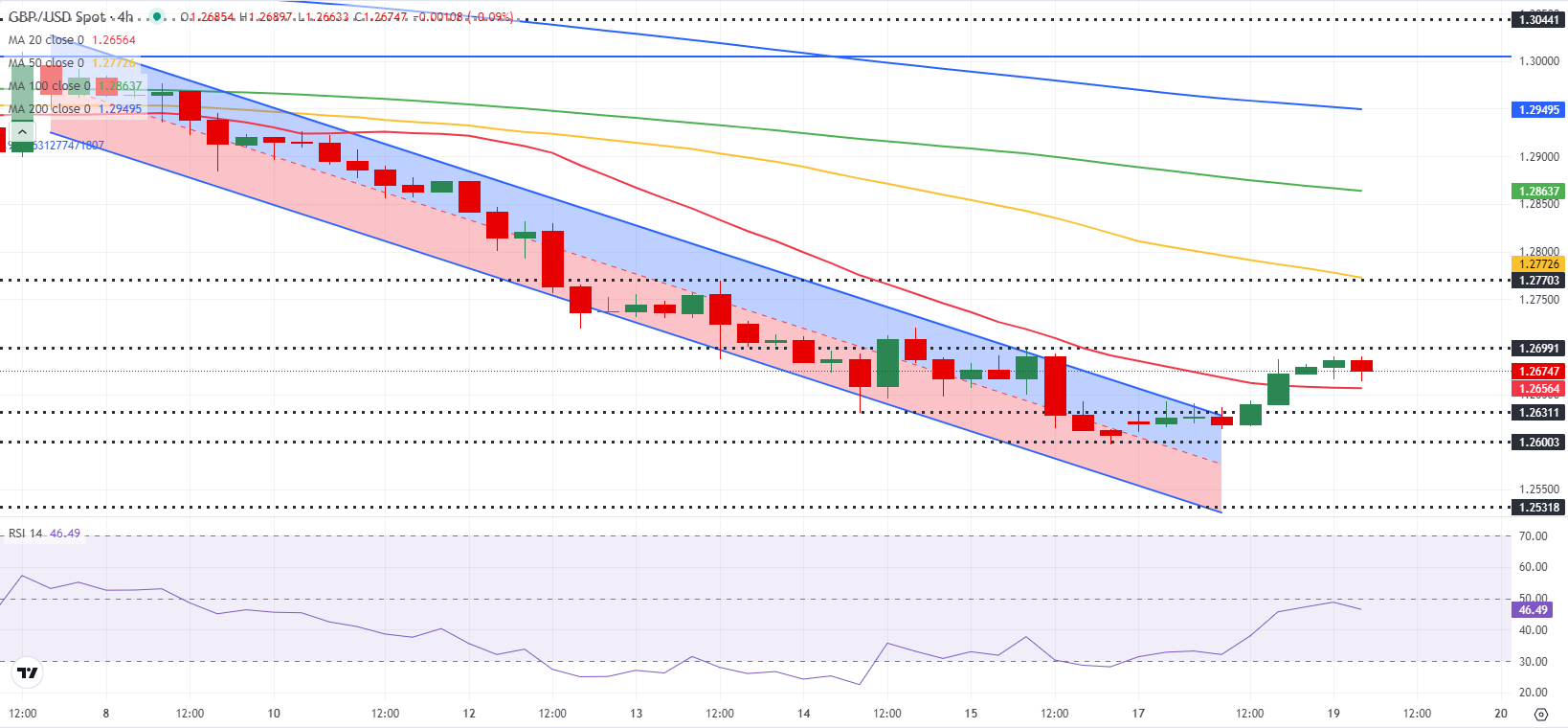- GBP/USD loses its recovery momentum after posting strong gains on Monday.
- BoE Governor Bailey will testify before the UK Treasury Select Committee.
- The near-term technical outlook suggests that bulls remain hesitant.
GBP/USD gathered bullish momentum and gained nearly 0.5% on Monday, snapping a six-day losing streak in the process. The pair, however, lost its traction after approaching 1.2700 and started to edge lower toward 1.2650 in the European morning on Tuesday.
British Pound PRICE This week
The table below shows the percentage change of British Pound (GBP) against listed major currencies this week. British Pound was the strongest against the Japanese Yen.
| USD | EUR | GBP | JPY | CAD | AUD | NZD | CHF | |
|---|---|---|---|---|---|---|---|---|
| USD | -0.34% | -0.40% | 0.25% | -0.48% | -0.75% | -0.44% | -0.45% | |
| EUR | 0.34% | 0.11% | 0.70% | -0.02% | -0.26% | 0.01% | 0.00% | |
| GBP | 0.40% | -0.11% | 0.59% | -0.13% | -0.38% | -0.10% | -0.12% | |
| JPY | -0.25% | -0.70% | -0.59% | -0.72% | -0.92% | -0.63% | -0.62% | |
| CAD | 0.48% | 0.02% | 0.13% | 0.72% | -0.25% | 0.03% | 0.03% | |
| AUD | 0.75% | 0.26% | 0.38% | 0.92% | 0.25% | 0.27% | 0.27% | |
| NZD | 0.44% | -0.01% | 0.10% | 0.63% | -0.03% | -0.27% | -0.01% | |
| CHF | 0.45% | -0.00% | 0.12% | 0.62% | -0.03% | -0.27% | 0.00% |
The heat map shows percentage changes of major currencies against each other. The base currency is picked from the left column, while the quote currency is picked from the top row. For example, if you pick the British Pound from the left column and move along the horizontal line to the US Dollar, the percentage change displayed in the box will represent GBP (base)/USD (quote).
The selling pressure surrounding the US Dollar (USD) helped GBP/USD stretch higher in the second half of the day on Monday. In the absence of high-tier macroeconomic data releases, the pullback seen in the US Treasury bond yields made it difficult for the USD to build on the previous week's gains.
Later in the session, Bank of England (BoE) Governor Andrew Bailey and members of the Monetary Policy Committee (MPC) will respond to questions from the UK Treasury Select Committee.
Following the November policy meeting, the BoE cut the policy rate by 25 basis points to 4.75% and revised inflation projections higher. In the post-meeting press conference, Governor Bailey noted that a gradual approach to cutting rates will help give them time to assess the impact of national insurance rise and other risks.
In case Bailey leaves the door open for another rate reduction in December, GBP/USD could have a hard time extending its rebound. On the other hand, the pair could push higher if Bailey suggests that they could skip a meeting to evaluate how the new budget will impact price and wage inflation before taking another policy step.
In the second half of the day, the US economic calendar will feature Building Permits and Housing Starts data for October, which are unlikely to trigger a noticeable market reaction.
GBP/USD Technical Analysis
GBP/USD broke out of the descending regression channel but the Relative Strength Index (RSI) indicator on the 4-hour chart turned south after coming within a touching distance of 50, reflecting buyers' hesitancy to bet on another leg higher.
On the upside, 1.2700 (round level, static level) aligns as immediate resistance before 1.2770 (50-period Simple Moving Average) and 1.2800 (round level, static level). Looking south, first support could be spotted at 1.2630 (static level, former resistance) ahead of 1.2600 (round level, static level) and 1.2530 (static level).
Pound Sterling FAQs
The Pound Sterling (GBP) is the oldest currency in the world (886 AD) and the official currency of the United Kingdom. It is the fourth most traded unit for foreign exchange (FX) in the world, accounting for 12% of all transactions, averaging $630 billion a day, according to 2022 data. Its key trading pairs are GBP/USD, also known as ‘Cable’, which accounts for 11% of FX, GBP/JPY, or the ‘Dragon’ as it is known by traders (3%), and EUR/GBP (2%). The Pound Sterling is issued by the Bank of England (BoE).
The single most important factor influencing the value of the Pound Sterling is monetary policy decided by the Bank of England. The BoE bases its decisions on whether it has achieved its primary goal of “price stability” – a steady inflation rate of around 2%. Its primary tool for achieving this is the adjustment of interest rates. When inflation is too high, the BoE will try to rein it in by raising interest rates, making it more expensive for people and businesses to access credit. This is generally positive for GBP, as higher interest rates make the UK a more attractive place for global investors to park their money. When inflation falls too low it is a sign economic growth is slowing. In this scenario, the BoE will consider lowering interest rates to cheapen credit so businesses will borrow more to invest in growth-generating projects.
Data releases gauge the health of the economy and can impact the value of the Pound Sterling. Indicators such as GDP, Manufacturing and Services PMIs, and employment can all influence the direction of the GBP. A strong economy is good for Sterling. Not only does it attract more foreign investment but it may encourage the BoE to put up interest rates, which will directly strengthen GBP. Otherwise, if economic data is weak, the Pound Sterling is likely to fall.
Another significant data release for the Pound Sterling is the Trade Balance. This indicator measures the difference between what a country earns from its exports and what it spends on imports over a given period. If a country produces highly sought-after exports, its currency will benefit purely from the extra demand created from foreign buyers seeking to purchase these goods. Therefore, a positive net Trade Balance strengthens a currency and vice versa for a negative balance.
Information on these pages contains forward-looking statements that involve risks and uncertainties. Markets and instruments profiled on this page are for informational purposes only and should not in any way come across as a recommendation to buy or sell in these assets. You should do your own thorough research before making any investment decisions. FXStreet does not in any way guarantee that this information is free from mistakes, errors, or material misstatements. It also does not guarantee that this information is of a timely nature. Investing in Open Markets involves a great deal of risk, including the loss of all or a portion of your investment, as well as emotional distress. All risks, losses and costs associated with investing, including total loss of principal, are your responsibility. The views and opinions expressed in this article are those of the authors and do not necessarily reflect the official policy or position of FXStreet nor its advertisers. The author will not be held responsible for information that is found at the end of links posted on this page.
If not otherwise explicitly mentioned in the body of the article, at the time of writing, the author has no position in any stock mentioned in this article and no business relationship with any company mentioned. The author has not received compensation for writing this article, other than from FXStreet.
FXStreet and the author do not provide personalized recommendations. The author makes no representations as to the accuracy, completeness, or suitability of this information. FXStreet and the author will not be liable for any errors, omissions or any losses, injuries or damages arising from this information and its display or use. Errors and omissions excepted.
The author and FXStreet are not registered investment advisors and nothing in this article is intended to be investment advice.
Recommended Content
Editors’ Picks

AUD/USD consolidates its recent substantial gains to over one-week high
AUD/USD holds steady above the 0.6300 mark during the Asian session on Tuesday and remains close to a one-and-half-week top touched the previous day. The USD finds some support following the recent sell-off and caps the pair near the 100-day SMA amid the escalating US-China trade war.

USD/JPY trades with positive bias above 143.00; upside potential seems limited
USD/JPY gains some positive traction on Tuesday and now seems to have snapped a three day losing streak to a multi-month low touched last week. The upbeat market mood undermines the safe-haven JPY and lends support amid a modest USD uptick.

Gold price holds steady above $3,200; remains close to all-time peak
Gold price trades above the $3,200 mark following the previous day's modest pullback from a fresh record high as the escalating US-China trade war continues to underpin the safe-haven bullion. Moreover, the Fed rate cut bets lend support to the XAU/USD.

Solana ETF to debut in Canada after approval from regulators
Solana ETF will go live in Canada this week after the Ontario Securities Commission greenlighted applications from Purpose, Evolve, CI and 3iQ. The products will allow staking, enabling investors to earn yield on their holdings.

Is a recession looming?
Wall Street skyrockets after Trump announces tariff delay. But gains remain limited as Trade War with China continues. Recession odds have eased, but investors remain fearful. The worst may not be over, deeper market wounds still possible.

The Best brokers to trade EUR/USD
SPONSORED Discover the top brokers for trading EUR/USD in 2025. Our list features brokers with competitive spreads, fast execution, and powerful platforms. Whether you're a beginner or an expert, find the right partner to navigate the dynamic Forex market.
